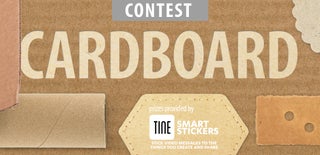Introduction: Modular Honeycomb Shelves
Hi All! Today I’m going to share with you on how to make a Modular Honeycomb Shelf with cardboard. I love honeycomb type shelves and I was inspired to make one myself after reading Instructables from Andrew Cleveland for his Beehive-Shelves and vickyadrian’s work on Honeycomb-Cardboard .
As for the main material I have dismiss the usage of wood since I have no power tools to work with; plus I’m bad at woodworking. Like vickyadrian did, I chose cardboard because it’s cheap (well, basically it’s free) and easy to work with. My method of building will be different from his/her though, as I’ll show you later.
Step 1: Gather Your Materials
- Double Wall Corrugated Cardboard Sheets (my cardboard thickness is around 7mm)
- Normal Cardboard
- Cutter
- Glue (I use white glue, it sticks the cardboards well)
- Binder Clip (get the biggest one, it need to be able to bind at least 1” minimum thickness)
- Masking tape or craft tape
- Paint
- Spray paint
- Putty filler
- Sandpaper
Step 2: Shelf Design and Template
The dimension of the shelf are; 266 mm length x 187 mm height x 150 mm depth. It is quite small for a shelf but considering that we are using cardboard here, I kinda worried that a bigger one will compromise the structure integrity. You can make the size bigger while adding more layers (thickness) of the cardboard.
My idea to build this shelf is by ‘sandwiching’ the corrugated cardboard with a layer of normal cardboard. This will turn the corrugated cardboard into a wood plank-like shape to make it easier to shape and glued.
You can see the template measurement in the picture above. Please note that my corrugated cardboard thickness is 7 mm, if your cardboard has different thickness do adjust the dimensions accordingly.
Step 3: Draw and Cut the Template
Draw the templates on the cardboard; there will be two (2) template A – for the top and bottom, and four (4) template B – for the sides. That makes it a total of six (6) cardboard ‘planks’.
Step 4: Fold the Cardboard
Crease the cardboard to make it easier to bend and fold. Fold the cardboard as an envelope for the corrugated cardboard.
Step 5: Cut the Corrugated Cardboard
Cut the corrugated cardboard according to the size of the cut out template. Insert the corrugated cardboard into the folded cardboard. Apply a plenty amount of glue to ‘sandwich’ it together. Use the binder clip to clamp the cardboard while the glue dries.
Once dried, cut the excess cardboard on both sides. Use the outer cardboard angle as a guide (that’s the reason for the sandwich cardboard).
The angle is important to attach the cardboard planks together. If the angle is a bit off, you’ll have a hard time to glue it together, and it wouldn’t shape like a perfect hexagon like we intended to.
Step 6: Glue the "Planks"
At this moment you'll have a total of six (6) cardboard planks. To make it easy to glue it together, first arrange the planks on a flat surface. Use masking/craft tape to hold the planks. Turn it over and apply glue along the connecting edge of each planks.
Next fold the planks to make a hexagon shape. Here's a tip on how to make sure your shelf is really hexagon. Draw a template of the hexagon shape (from the template in Step 2) on a piece of paper. While the glue is still wet rest the shelf on top of the paper. This serves as a guide for you to make sure that you have the exact hexagonal shape that you want.
Step 7: Putty Filling, Sanding, and Painting
Remove the masking tape and start filling the gaps with putty filler. Once done, smooth the rough surface with sandpaper. Be cautious during sanding because you might peel off the cardboard skin (we are dealing with cardboard here, not wood) . I applied a thin coat of white paint (water base) to the shelf and then finished the coating with acyrilic spray paint.
Step 8: The Secret of Modular Shelves
It wouldn’t be a honeycomb shape with a single hexagon so you need to build a few more shelves to stack it together. The secret to the modular shelving is the binder clip. I first spray paint the binder clip white to match the shelf color.
Use the binder clip to attach the shelves together. Once you clipped it in, remove the clip's handle.
Step 9: Arrange the Shelves to Your Liking
With the binder clip you can arrange your honeycomb shelves position and pattern to your liking. Hence I called it modular honeycomb shelves =)

Third Prize in the
Cardboard Contest 2016

Runner Up in the
Dorm Hacks Contest 2016













